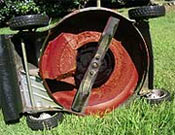This news item expired on Sunday, March 31, 2013 so the information below could be outdated or incorrect.
Don't miss the video link at the bottom of the page!
Lawns:
-
It will soon be time to crank up the lawn mower. Did you get the blade sharpened?
-
If you have not yet gotten around to the spring fertilizer application, you’re almost out of time. Products containing slow release nitrogen should be put out no later than the first week of March. Quick-release products such as 10-10-10 can be applied through the end of the month.
-
If crabgrass has been a problem, mid-March is a good time to spread “crabgrass preventer” for best results.
-
It can be difficult to time applications of “weed and feed” products for good results. Early March would be only slightly early for the weed prevention
 and a little later than desired for the slow release nitrogen.
and a little later than desired for the slow release nitrogen.
Ornamentals:
-
Summer blooming shrubs and trees such as butterfly bush, rose-of-Sharon and crape myrtle can be pruned now.
-
Do not prune spring blooming plants until after the flowers fade.
-
March is a good time to do severe pruning when overgrown shrubs need to be renovated.
-
When the weather breaks, plant trees, shrubs, perennials.
-
Repot and trim up house plants. Rejuvenate hanging baskets and use cuttings to start new baskets.
-
Sow seeds for larkspur, poppies and snapdragons.
-
Check house plants for insect infestations. Plants can be taken outside on a warm day for spraying, but bring them in before dark.
Fruits:
-
Remove straw or row covers from strawberry plants as soon as flowers appear.
-
Plant all types of fruit crops.
-
Prune fruit trees, grapes and brambles.
-
The Extension office has video tapes on pruning grapes, blueberries and fruit trees that are available for loan.
-
Fertilize all fruit crops.
Vegetables:
-
Plant English and edible-pod peas, onions, and kale.
-
Wait until late March to set out potatoes and plants of cabbage, broccoli and cauliflower.
-
Start transplants indoors for tomatoes, peppers and eggplants mid-month. They will need 6 to 8 weeks to be ready for the garden.
Other:
-
It’s lovely to have a bouquet of daffodils in the house. If you want to mix daffodils with other cut flowers, though, take an extra step first. The sap from daffodil stems can clog the stems of other plants. The recommendation is to let the daffodils stand in water by themselves for at least 6 hours before placing them in with other flowers.
For more information, view BCTV 2's March Garden Chores video, or call Buncombe County Cooperative Extension at 255-5522.